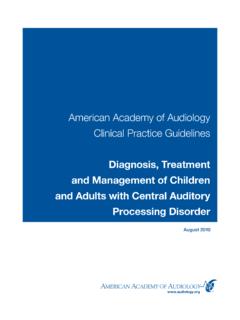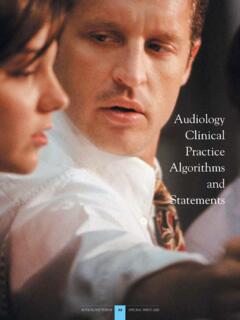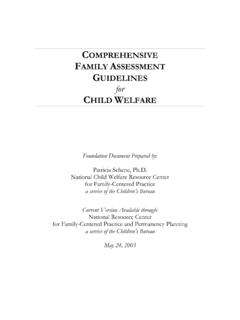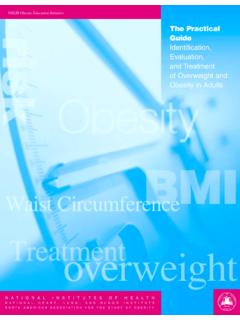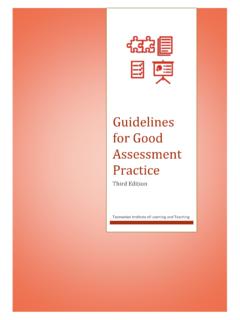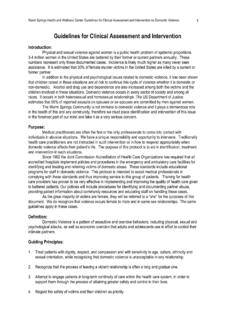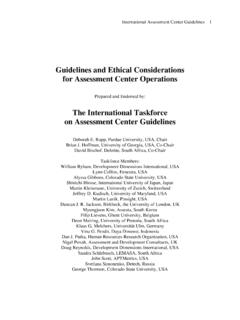Transcription of Audiologic Guidelines for the Assessment of …
1 Audiologic Guidelines for the Assessment of Hearing in Infants and Young Children August 2012 Audiologic Guidelines for the Assessment of Hearing in Infants and Young Children 2 Committee Members Mona M. Dworsack-Dodge, Senior Audiologist Research and Development GN Otometrics A/S Denmark Judith Gravel, Alison M. Grimes, AuD Clinical Manager, Audiology, UCLA Medical Center Assistant Clinical Professor, Head and Neck Surgery David Geffen School of Medicine at UCLA Los Angeles, CA Lisa Hunter, Associate Professor and Senior Director Division of Audiology Cincinnati Children's Medical Center University of Cincinnati Cincinnati, OH Karen Johnson, Clinical Research Coordinator Children s Auditory Research and Evaluation Center House Research Institute Los Angeles, CA Marilyn Neault, Director.
2 Habilitative Audiology Program Children's Hospital Boston Waltham, MA 1 Dr. Gravel served on this committee until her death in December of 2008. She contributed substantially to this document and her work is greatly appreciated. Jack Roush, Professor and Director Division of Speech and Hearing Sciences University of North Carolina School of Medicine Chapel Hill, NC Yvonne Sininger, Professor, Head & Neck Surgery University of California Los Angeles Los Angeles, CA Anne Marie Tharpe, Professor and Chair Vanderbilt Bill Wilkerson Center Department of Hearing & Speech Sciences Vanderbilt University School of Medicine Nashville, TN.
3 Wende Yellin, , Chair Associate Professor Department of Communication Sciences and Disorders Northern Arizona University Flagstaff, AZAudiologic Guidelines for the Assessment of Hearing in Infants and Young Children 3 Introduction The American Academy of Audiology supports early identification, Assessment , and intervention for all types of hearing loss in infants and young children to minimize deleterious effects on speech, language, education, and social/psychological development. These Clinical Practice Guidelines describe recommended practices for the Assessment of auditory function in children.
4 The most appropriate protocol will be individualized for each child based on his or her developmental and/or chronological age and other relevant factors. Thus, test procedures needed to address this population are diverse. The scope-of-practice and responsibility of the audiologist is to determine the appropriate test procedures to use for each child. The purpose of this document is to describe recommended practices for the Assessment of auditory function in children. The Pediatric Hearing Assessment Task Force has delineated the following areas that make up the pediatric Audiologic Assessment test battery.
5 Behavioral observation Visual Reinforcement Audiometry (VRA) Conditioned Play Audiometry (CPA) Frequency-specific stimuli Speech Audiometry Physiologic Assessments, including o Acoustic Immittance, including tympanometry and acoustic reflex testing o Otoacoustic Emission (OAE) testing Electrophysiologic Audiometry including o Auditory Brainstem Response (ABR) o Auditory Steady State Response (ASSR) audiometry The Test Battery Approach When evaluating auditory function in infants and young children, a variety of techniques must be incorporated.
6 The use of a test battery approach to determine a child s auditory profile is described as the cross-check principle (Jerger and Hayes, 1976). Current practice of pediatric audiology dictates that both behavioral and physiologic, and in some cases, electrophysiologic assessments should be incorporated into a complete evaluation to confirm results across various procedures. While the use of various techniques may require more than one test session over a period of time before accurate and reliable results are obtained, it is imperative that the diagnostic process be accomplished as quickly as possible.
7 The 2007 Joint Committee on Infant Hearing 1-3-6 Guidelines recommend diagnosis of hearing loss by 3 months of age and intervention by 6 months of age. Of course, earlier diagnosis and intervention would be acceptable and is preferred. For any infant under the age of 3 years for whom hearing aids and/or cochlear implant(s) are to be fitted or recommended, at least one electrophysiological measure of threshold prediction should be completed (JCIH, 2007). Audiologic Guidelines for the Assessment of Hearing in Infants and Young Children 4 The gold standard of hearing measurement is behavioral Assessment .
8 The goal of behavioral testing is to establish hearing thresholds across the speech frequencies for each ear, and to assess, when possible, speech perception at a supra-threshold level. This information is necessary when making decisions regarding amplification, aural habilitation, and educational strategies. Appropriate behavioral procedures will depend upon the child s developmental, cognitive and linguistic level, visual and motor development, and ability to respond appropriately. As children mature, more specific behavioral information can be obtained.
9 In this document, auditory behavioral procedures that change with developmental level, including behavioral observation, Visual Reinforcement Audiometry (VRA), and Conditioned Play Audiometry (CPA), are described in detail. The use of a team testing approach for Visual Reinforcement Audiometry (VRA) and Conditioned Play Audiometry (CPA) may be helpful in some circumstances, such as when testing children who have developmental delays. The use of an appropriately trained student and/or test assistant may help to maintain the child's attention and proper placement of the transducers.
10 Physiologic and electrophysiologic tests are used to assess specific auditory function as well as estimate or infer auditory thresholds or sensitivity without requiring an overt behavioral response from the child. In this document, physiological and electrophysiological procedures, including acoustic immittance (tympanometry and acoustic reflex threshold tests), otoacoustic emission (OAE) tests, and auditory brainstem response (ABR) audiometry, also contribute to Audiologic diagnosis. For final determination of type and degree of hearing loss, results from behavioral, physiologic and electrophysiologic testing should be combined.
